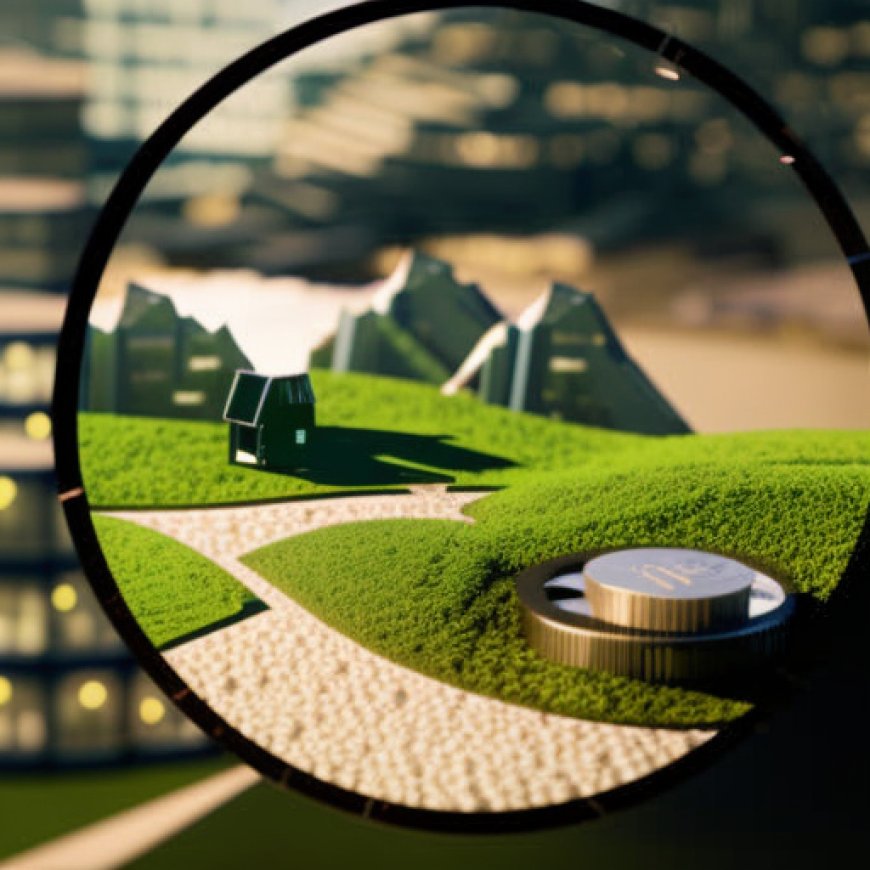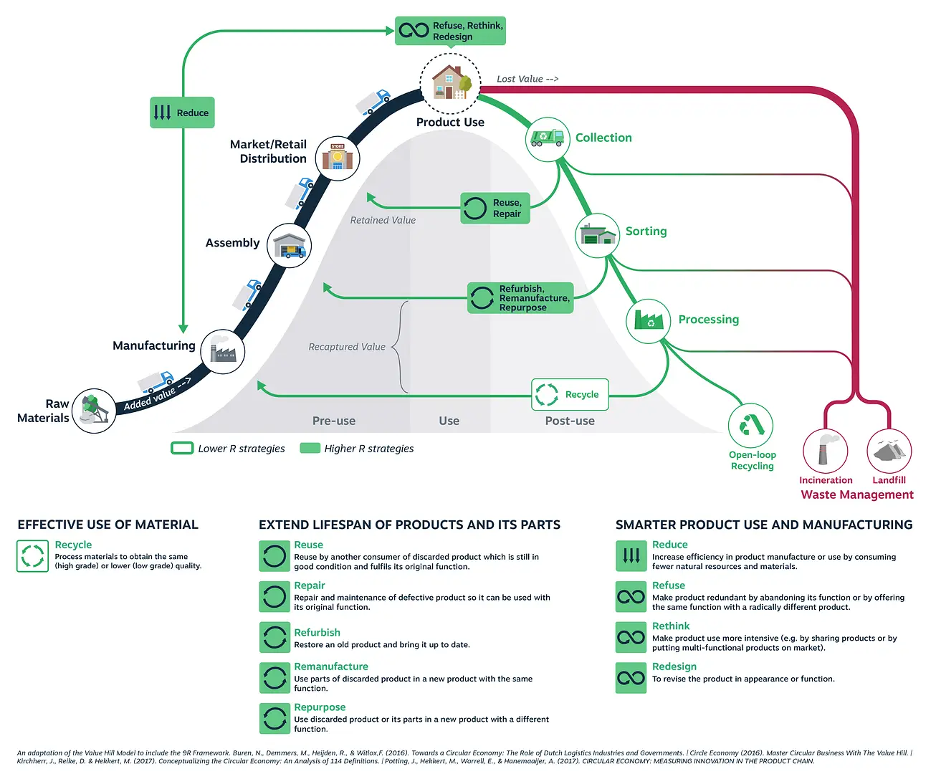Scaling the value hill: how to incorporate circular economy practices into the building sector | GreenBiz
Scaling the value hill: how to incorporate circular economy practices into the building sector GreenBiz


More than 90% of all materials extracted and used in industrial processes are wasted
According to the World Green Building Council, more than 90% of all materials extracted and used in industrial processes are wasted. This presents a significant business opportunity to convert that waste into valuable resources. Applying the circular economy to the building sector has the potential to yield an annual net profit gain of $31-46 billion by 2030 and $234-360 billion by 2050, as stated in a 2023 report from McKinsey.
The concept of circularity in the built environment
The World Green Building Council defines a building as circular if it optimizes the use of resources while minimizing waste throughout its whole lifecycle. This concept can be applied at multiple scales within the built environment, from individual building products to entire cities. By embracing circularity, the building sector can not only reduce waste but also decarbonize building products and enhance the resilience and adaptability of buildings.
Building product decarbonization
According to a report by McKinsey for the World Economic Forum, applying circularity could abate 75% of embodied emissions from the built environment. Embodied carbon refers to emissions generated during the extraction, production, transport, and manufacturing stages of a product’s life. Although it accounts for 11% of emissions from the building sector, it has historically been overlooked. However, building professionals, led by non-profits like Mindful Materials and the Carbon Leadership Forum, are now working to provide data on the lifecycle impacts of building products and materials.
The circular approach to decarbonizing products involves replacing the extraction of raw materials from nature with urban mining, which captures valuable materials from the built environment’s waste stream. Reusing these otherwise wasted materials and products in the manufacturing process helps offset or avoid carbon emissions.
Circular value creation
The “value hill” model illustrates how circular opportunities can be harnessed in the building lifecycle. As materials progress through the stages of manufacturing, their value increases, reaching its peak at the top of the hill. In a linear economy, this value drops off and is lost. However, circularity enables multiple opportunities to recapture some of that value.

Incorporating circular practices
Saint-Gobain, a French firm with a 350-year history in manufacturing building products, is committed to achieving net zero carbon emissions by 2050. The company is working across the lifecycle of its products to incorporate circular practices. Dennis Wilson, Vice President of ESG and Managing Director of Circular Economy Solutions for North America, stated that they are actively collaborating with suppliers to report specific data on scope 3 emissions and reduce the associated emissions from materials.
Circularity enables multiple opportunities to recapture some of the value of discarded materials.
Saint-Gobain aims to complete life cycle assessments (LCAs) for all their products by 2030. LCAs quantify the impacts across a product’s lifespan and provide crucial information for architects and engineers when selecting materials. The company is also exploring ways to repurpose materials that would otherwise end up in landfills. For example, they have partnered to reuse pre- and post-consumer windshield glass in manufacturing insulation. This approach helps reduce emissions and energy consumption compared to using virgin raw materials.
The Building Product Forum
While Europe has made progress in adopting circular economy best practices, North America lags behind. To fully embrace the value of circularity, the building industry needs to come together to accelerate circular solutions. GreenBiz will host an event called “The Building Product Forum” at Circularity 2024, taking place from May 22-24th in Chicago. This forum will bring together leading building product manufacturers to collaborate on the future of circular building materials. It offers a unique opportunity for product manufacturers from across the building sector to align efforts and work towards a more sustainable and circular built world.
SDGs, Targets, and Indicators
SDGs Addressed:
- SDG 12: Responsible Consumption and Production
- SDG 13: Climate Action
- SDG 9: Industry, Innovation, and Infrastructure
Targets Identified:
- Target 12.2: By 2030, achieve the sustainable management and efficient use of natural resources
- Target 12.5: By 2030, substantially reduce waste generation through prevention, reduction, recycling, and reuse
- Target 13.2: Integrate climate change measures into national policies, strategies, and planning
- Target 9.4: By 2030, upgrade infrastructure and retrofit industries to make them sustainable, with increased resource-use efficiency and greater adoption of clean and environmentally sound technologies and industrial processes
Indicators:
- Indicator 12.2.1: Material footprint, material footprint per capita, and material footprint per GDP
- Indicator 12.5.1: National recycling rate, tons of material recycled
- Indicator 13.2.1: Number of countries that have integrated mitigation, adaptation, impact reduction, and early warning measures into national policies, strategies, and planning
- Indicator 9.4.1: CO2 emissions per unit of value added
Explanation:
SDGs Addressed:
The issues highlighted in the article are connected to the following SDGs:
- SDG 12: Responsible Consumption and Production – The article discusses the potential of circular economy practices to optimize resource use and minimize waste in the building sector.
- SDG 13: Climate Action – The article emphasizes the importance of decarbonizing building products and reducing embodied emissions from the built environment.
- SDG 9: Industry, Innovation, and Infrastructure – The article mentions the need to upgrade infrastructure and retrofit industries to make them sustainable and adopt clean technologies and processes.
Targets Identified:
- Target 12.2: By 2030, achieve the sustainable management and efficient use of natural resources – The article highlights the potential of circular economy practices to optimize resource use and minimize waste in the building sector.
- Target 12.5: By 2030, substantially reduce waste generation through prevention, reduction, recycling, and reuse – The article discusses the circular approach to decarbonizing products and reusing wasted materials in the manufacturing process.
- Target 13.2: Integrate climate change measures into national policies, strategies, and planning – The article emphasizes the importance of decarbonizing building products and reducing embodied emissions from the built environment.
- Target 9.4: By 2030, upgrade infrastructure and retrofit industries to make them sustainable, with increased resource-use efficiency and greater adoption of clean and environmentally sound technologies and industrial processes – The article mentions the need to upgrade infrastructure and retrofit industries in order to achieve sustainability and adopt clean technologies and processes.
Indicators:
- Indicator 12.2.1: Material footprint, material footprint per capita, and material footprint per GDP – The article discusses the potential of circular economy practices to optimize resource use and minimize waste in the building sector, which can be measured by material footprint indicators.
- Indicator 12.5.1: National recycling rate, tons of material recycled – The circular approach to decarbonizing products and reusing wasted materials in the manufacturing process can be measured by indicators such as national recycling rates and tons of material recycled.
- Indicator 13.2.1: Number of countries that have integrated mitigation, adaptation, impact reduction, and early warning measures into national policies, strategies, and planning – The article emphasizes the importance of integrating climate change measures into national policies and planning.
- Indicator 9.4.1: CO2 emissions per unit of value added – The need to upgrade infrastructure and retrofit industries to make them sustainable and adopt clean technologies and processes can be measured by CO2 emissions per unit of value added.
Table: SDGs, Targets, and Indicators
| SDGs | Targets | Indicators |
|---|---|---|
| SDG 12: Responsible Consumption and Production | Target 12.2: By 2030, achieve the sustainable management and efficient use of natural resources | Indicator 12.2.1: Material footprint, material footprint per capita, and material footprint per GDP |
| SDG 13: Climate Action | Target 12.5: By 2030, substantially reduce waste generation through prevention, reduction, recycling, and reuse | Indicator 12.5.1: National recycling rate, tons of material recycled |
| Target 13.2: Integrate climate change measures into national policies, strategies, and planning | Indicator 13.2.1: Number of countries that have integrated mitigation, adaptation, impact reduction, and early warning measures into national policies, strategies, and planning | |
| SDG 9: Industry, Innovation, and Infrastructure | Target 9.4: By 2030, upgrade infrastructure and retrofit industries to make them sustainable, with increased resource-use efficiency and greater adoption of clean and environmentally sound technologies and industrial processes | Indicator 9.4.1: CO2 emissions per unit of value added |
Behold! This splendid article springs forth from the wellspring of knowledge, shaped by a wondrous proprietary AI technology that delved into a vast ocean of data, illuminating the path towards the Sustainable Development Goals. Remember that all rights are reserved by SDG Investors LLC, empowering us to champion progress together.
Source: greenbiz.com

Join us, as fellow seekers of change, on a transformative journey at https://sdgtalks.ai/welcome, where you can become a member and actively contribute to shaping a brighter future.







